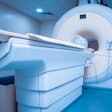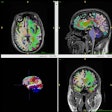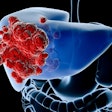A commercially available deep-learning (DL) algorithm can enable good quality seven-minute shoulder MRI exams, according to research published February 18 in Radiology.
The finding is from a study that validated a fast protocol in 121 clinical patients, with seven independent readers giving the algorithm high scores for reducing image noise and improving image sharpness, noted lead author Jan Vosshenrich, MD, of New York University in New York City, and colleagues.
“Despite the advantages of DL methods, concerns regarding the robustness and accuracy of DL-reconstructed images necessitate rigorous testing against external reference standards,” the group wrote.
Traditional MRI scans to assess shoulder joint injuries are lengthy and usually have barely acceptable image quality and signal-to-noise ratio due to patient motion, the authors explained. Patients often have trouble holding their shoulders still for the duration of the scan, which blurs anatomic detail.
DL algorithms have been developed over the past five years to reduce these “motion artifacts,” yet evidence on their diagnostic performance is scarce, the group noted. Thus, the researchers aimed to validate a seven-minute protocol enabled by a commercially available DL-based super-resolution augmentation algorithm (Deep Resolve Sharp, Siemens Healthineers).
The group analyzed images acquired using the fast protocol in adults with painful shoulder conditions who underwent 3-tesla shoulder MRI and arthroscopy between March and November 2023. Seven radiologists evaluated the MRI scan quality and the presence of artifacts using a Likert scale ranging from 1 (very bad/severe) to 5 (very good/absent).
According to the results, motion artifacts and image noise were minimal, with a ratings of 4 for each, and reconstruction artifacts were absent (a rating of 5). In addition, arthroscopy-validated abnormalities were detected on the imaging with good or better interreader agreement (κ ≥ 0.68), the group reported.
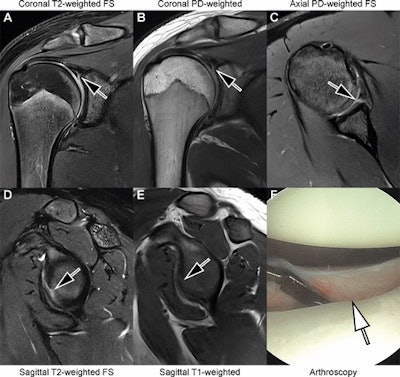 Images in an 18-year-old man with recurrent dislocations of the right shoulder. (A, B) Unenhanced coronal, (C) axial, and (D, E) sagittal deep learning super-resolution threefold parallel imaging -- accelerated turbo spin-echo MRI scans were obtained at 3-tesla field strength. (A) Coronal T2-weighted fat-suppressed (FS) and (B) coronal proton density (PD)-weighted MRI scans show a nondisplaced superior labral tear (arrows). (C) Axial proton density-weighted fat-suppressed, (D) sagittal T2-weighted fat-suppressed, and (E) sagittal T1-weighted MRI scans show continuation into a nondisplaced anteroinferior labral tear (arrows). All seven readers correctly diagnosed the arthroscopy-validated findings. (F) An arthroscopic photograph shows the anteroinferior labral tear (arrow). Image and caption courtesy of the RSNA.
Images in an 18-year-old man with recurrent dislocations of the right shoulder. (A, B) Unenhanced coronal, (C) axial, and (D, E) sagittal deep learning super-resolution threefold parallel imaging -- accelerated turbo spin-echo MRI scans were obtained at 3-tesla field strength. (A) Coronal T2-weighted fat-suppressed (FS) and (B) coronal proton density (PD)-weighted MRI scans show a nondisplaced superior labral tear (arrows). (C) Axial proton density-weighted fat-suppressed, (D) sagittal T2-weighted fat-suppressed, and (E) sagittal T1-weighted MRI scans show continuation into a nondisplaced anteroinferior labral tear (arrows). All seven readers correctly diagnosed the arthroscopy-validated findings. (F) An arthroscopic photograph shows the anteroinferior labral tear (arrow). Image and caption courtesy of the RSNA.
For instance, the scans allowed the readers to correctly categorize the supraspinatus-infraspinatus tendons as normal versus partial-thickness tear versus full-thickness tear with a sensitivity of 89%, a specificity of 90%, and an accuracy of 89%. They also achieved a sensitivity of 93%, a specificity of 73%, and an accuracy of 86% for diagnosing tears of the superior labrum.
“Seven-minute threefold parallel imaging-accelerated deep learning super-resolution shoulder MRI is robust; provides images with high quality and minimal motion artifacts; and has high diagnostic performance for diagnosing tendinous, labral, and osteocartilaginous shoulder abnormalities,” the group wrote.
In an accompanying editorial, Michael Tuite, MD, of the University of Wisconsin in Madison, noted that the study addresses many of the concerns that radiologists have had with switching to a fast shoulder protocol -- specifically, for instance, that the images were obtained with a preferred 14-cm field of view, which contained the typical five shoulder sequences that many radiologists favor.
Yet the main limitation of the study was that all patients were scanned on a 3-tesla MRI scanner with the latest deep learning software and the images were interpreted by musculoskeletal fellowship-trained radiologists, Tuite wrote.
“Future studies will be needed to see if a similar accuracy can be obtained on 1.5-T scanners and by radiologists without musculoskeletal fellowship training,” he added.
The full study is available here.


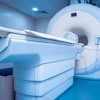

.fFmgij6Hin.png?auto=compress%2Cformat&fit=crop&h=100&q=70&w=100)

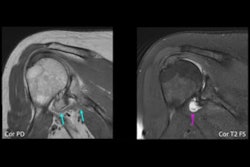
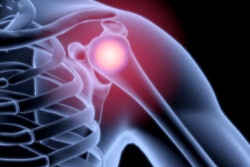
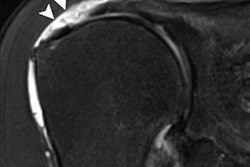
.fFmgij6Hin.png?auto=compress%2Cformat&fit=crop&h=167&q=70&w=250)
